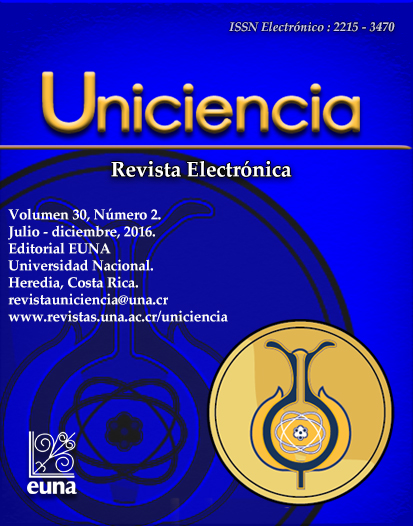FUsaM: Framework for Measuring Usability Mobile Applications Based on an SPL
DOI:
https://doi.org/10.15359/ru.30-2.3Keywords:
Usability, mobile applications, testing, software product line.Abstract
The widespread use of mobile devices and the heterogeneity of the users involves challenges when evaluating usability of mobile applications. It is important to have methodologies and tools that enable to perform specific usability studies for this type of applications in which the context of use is constantly changing. It is necessary that usability testing are transparent to the user, usability and context data are automatically collected, the test code are not intrusive in the tested application and the tests support the variability of the devices. To achieve the above features, this article presents a framework called FUsaM (Mobile Usability Framework) which is extensible and can generate and integrate usability testing in mobile applications. The design and implementation approach is based on Software Product Line (SPL) combined with Features Oriented Programming (FOP) and Aspect Oriented Programming (AOP). A case study is also presented to prove the functionality.
References
Balagtas-Fernández, F. y Hussmann, H. (2009). A Methodology and Framework to Simplify Usability Analysis of Mobile Applications. 24th IEEE/ACM International Conference on Automated Software Engineering, 520-524.
Batory, D. (2005). Feature models, grammars, and propositional formulas. Software Product Lines, 9th Int. Conference, LNCS, SPLC 2005, Rennes, France, Proceedings, vol. 3714, Springer (2005), pp. 7-20.
Clements, P. y Northrop, L. (2001). Software Product Lines: Practices and Patterns. Addison-Wesley Longman Publishing Co.. Boston, USA.
Hornbæk, K. (2006). Current practice in measuring usability: Challenges to usability studies and research. International Journal of Human-Computer Studies, 79-102.
ISO 9241-11 (1998). Ergonomic requirements for office work with visual display terminals (VDTs.) - Part 11: Guidance on usability.
Ivory, M. y Hearst, M. (2001). The state of the art in automating usability evaluation of user interfaces. Journal ACM Computing Surveys (CSUR), 470-516.
Kang, K., Cohen, S., Hess, J., Novak, W. y Peterson, S. (1990). Feature-oriented domain analysis (FODA) feasibility study. Technical Report CMU/SEI-90-TR-21, Software Engineering Institute, Carnegie Mellon University.
Kronbauer, A. H. y Santos, C. (2011). Um modelo de avaliação da usabilidade baseado na captura automática de dados de interação do usuário em ambientes reais. Brazilian Symposium on Human Factors in Computing Systems and the 5th Latin American Conference on Human-Computer Interaction. Porto Alegre, Brazil, 114-123.
Kronbauer, A., Santos, C. y Vieira, V. (2012). Um estudo experimental de avaliação da experiência dos usuários de aplicativos móveis a partir da captura automática dos dados contextuais e de interação. Brazilian Symposium on Human Factors in Computing Systems. Porto Alegre, Brazil, 305-314.
Lettner, F. y Holzmann, C. (2012). Automated and Unsupervised User Interaction Logging as Basis for Usability Evaluation of Mobile Applications. International Conference on Advances in Mobile Computing & Multimedia. New York, USA, 118-127.
Loughran, N., Sampaio, A. y Rashid, A. (2006). From requirements documents to feature models for aspect oriented product line implementation. Satellite Events at the MoDELS Conf., 262-271.
Lyons, K. y Starner, T. (2001). Mobile Capture for Wearable Computer Usability Testing. ISWC '01, 5th IEEE International Symposium on Wearable Computers, 69-76.
Pohl, K., Böckle, G. y Linden, F. (2005). Linden Software Product Line Engineering: Foundations, Principles and Techniques. Springer.
Salazar, J. (2009). Herramienta para el modelado y configuración de modelos de características. Malaga, España.
Shaw, M. (2003). Writing Good Software Engineering Research Papers. Minitutorial. Proceedings of the 25th International Conference on Software Engineering. IEEE Computer Society, 726-736.
Thüm, T., Kästner, C., Benduhn, F., Meinicke, J., Saake, G. y Leich, T. (2014). FeatureIDE: An Extensible Framework for Feature-Oriented Software Development. Science of Computer Programming, 79(0):70-85. http://wwwiti.cs.uni-magdeburg.de/iti_db/research/featureide
Zhang, D. y Adipat, B. (2005). Challenges, Methodologies, and Issues in the Usability Testing of Mobile Applications. International Journal of Human-Computer Interaction, 293-308.
Downloads
Published
Issue
Section
License
Authors who publish with this journal agree to the following terms:
1. Authors guarantee the journal the right to be the first publication of the work as licensed under a Creative Commons Attribution License that allows others to share the work with an acknowledgment of the work's authorship and initial publication in this journal.
2. Authors can set separate additional agreements for non-exclusive distribution of the version of the work published in the journal (eg, place it in an institutional repository or publish it in a book), with an acknowledgment of its initial publication in this journal.
3. The authors have declared to hold all permissions to use the resources they provided in the paper (images, tables, among others) and assume full responsibility for damages to third parties.
4. The opinions expressed in the paper are the exclusive responsibility of the authors and do not necessarily represent the opinion of the editors or the Universidad Nacional.
Uniciencia Journal and all its productions are under Creative Commons Atribución-NoComercial-SinDerivadas 4.0 Unported.
There is neither fee for access nor Article Processing Charge (APC)






